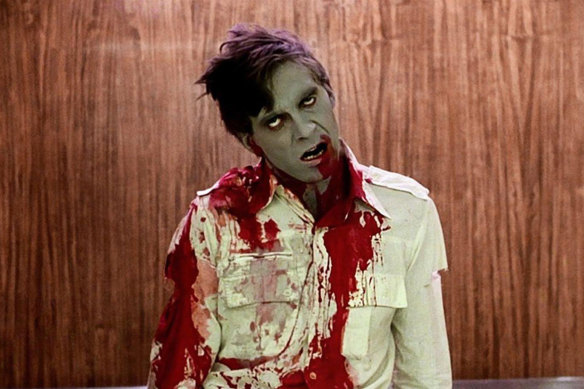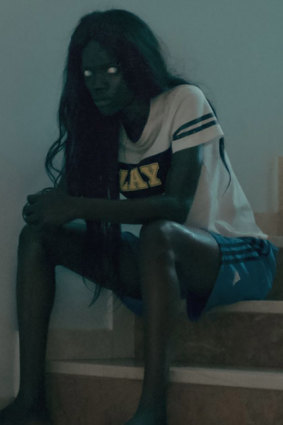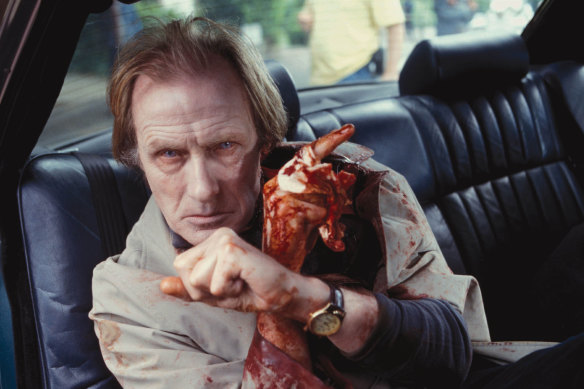How do you like your zombies? Classically slow and lumbering, but aggressive and hungry for brains? Or zombies who can run, the type who can wield a weapon, or kill with their spit, or perhaps the kind that are mostly fungus? Zombies – the undead, the living dead, the reanimated – have had many cinematic iterations and remain, seemingly, impervious to changing trends.
A classic zombie from George Romero’s 1978 film Dawn of The Dead.
Horror movies and their monsters – vampires, alien invaders, werewolves – have long been vehicles for social commentary, reflecting the anxieties of the day. But howling quadrupeds and bloodsucking aristocrats (even pouting teenage ones) come in and out of fashion; it’s the monster that isn’t even alive that has had the most longevity. From its origins in Haitian folklore, the zombie in cinema (and television) has evolved into something entirely different that encapsulates our fears.
The late auteur George Romero is credited with creating the zombie as we know and love/fear it today, in his 1968 classic Night of the Living Dead. His low-budget tale, shocking for both its gore and its social commentary (put simply: humans are as bad, if not worse, than monsters), became a cult hit, making more than $30 million worldwide – and spawning an entire genre.
Night of the Living Dead never actually uses the term ‘zombie’; Romero’s creatures were referred to only as “ghouls” in that film. (The biggest zombie fiction of recent years, the TV adaptation of the comic book series The Walking Dead, never used the term either).
A scene from the “zombie adjacent” film Atlantics.
But by Romero’s 1978 sequel Dawn of the Dead, he had claimed the word (and capitalism as his new subtext, with mindless zombies shuffling through a mall). As a canvas, the zombie is malleable, having been a metaphor for everything from the civil rights struggle, wealth distribution and late-stage capitalism, contagions and diseases such as AIDS, terrorism and most recently, climate change.
When Night of the Living Dead was released, few people were familiar with the term ‘zombie’, says Swinburne University Cinema and Screen Studies lecturer Dr Andrew Lynch. “There had only been White Zombie (a 1932 film starring Bela Lugosi) and I Walked with a Zombie (a 1943 film in which a nurse uses voodoo to save a patient), which both … loosely interpreted voodoo mythology and folklore into almost-but-not-quite exploitation films,” Lynch says. And the zombies weren’t actually the bad guys. “The big ‘monster’ or villain was the person controlling them; very different to the zombies we have today.”
This month, ACMI celebrates 50 years of zombie cinema in Focus on the Dead, a program tied to a two-day conference organised by Dr Lynch, Mapping Global Horror: Australia, Japan and Beyond.
The film program features seven movies, starting with Romero’s Trilogy of the Dead, including the Australian premiere of the newly restored 3D version of Dawn of the Dead. There’s also the 2016 South Korean action-horror Train to Busan, The Last Man on Earth, the 1964 adaptation of Richard Matheson’s I Am Legend, which influenced Romero, and two “zombie-adjacent” films, the 2020 Australian horror Relic and the 2019 Senegalese horror Atlantics, a ghost story that also explores inequity and migration.
ACMI Film and TV Curator and Focus on the Dead programmer Reece Goodwin wanted to draw a line from Romero to modern zombie films. The program, he says, aims to offer a “thought-provoking exploration of the horror genre and its many forms.”
What is it about the zombie that has seen it endure? “There’s more to all (zombie films) than meets the eye, but they all ask the audience one question,” Goodwin says. “What would you do to survive in this situation?”
Zombies themselves have changed since Romero’s ghouls, and so has the idea of survival. “Romero’s trilogy is based in left-wing politics, but zombie films today are actually getting a bit more right-wing and almost … survivalist,” says Goodwin.
In the long-running TV series The Walking Dead, the z-word was never used.Credit:AMC
Popular contemporary zombie apocalypses today tend to feature incapable governments, societal collapse, and the only survivors those who are heavily fortified. “Which is almost far right, in a way,” Goodwin says. “They’re still asking ‘what would you do to survive?’, but they’re steering us towards … stocking up on guns and weapons, battening down the hatches and locking yourself away, waiting for the attack and being prepared.”
It’s now a “silent majority” descending on us,” he says. “We’ve said for a long time that horror films capture the fears and anxieties of society, and I think zombie films are really capturing and articulating those fears, in Western society at least, today.”
The creatures themselves have also evolved. In Danny Boyle’s 2002 post-apocalyptic horror 28 Days Later, for example, the vicious zombies are shockingly athletic, as are the hyperkinetic undead on board the high-speed train in Train to Busan.
Bill Nighy in a scene from the “zom-rom-com” Shaun of the Dead.Credit:UIP
“Focus on the Dead really reflects that fracturing of the genre,” says Goodwin. “We cherry-picked the outliers – the ones that weren’t necessarily going in that (right-wing) political direction. I think because there are lots of different offshoots of the subgenre, it has infiltrated a lot of different parts of life.”
Not all zombie fiction involves gun-toting preppers – the undead have also shuffled their way into comedies (Shaun of the Dead; Zombieland), queer films (Bruce LaBruce’s LA Zombie), Nazi action (Dead Snow), “zom-rom-coms” such as Warm Bodies and Pride and Prejudice and Zombies, and even porn titles (best to Google those yourself).
“As long as you get the scares in, you can do almost anything you want with horror, and tell messages that reflect cultural or national fears and anxieties,” says Goodwin. “An Australian-made zombie movie, such as Cargo, will obviously speak to cultural fears differently than a South Korean film would, but you can use them for all sorts of things.”
Where to next? In The Last of Us, currently streaming on Binge, The Infected (we know what that really means) are afflicted by a fungus that has flourished as a result of climate change.
“I think next maybe we’ll make it a bit more personal,” says Goodwin. “We might find ourselves indoors again at any moment, so maybe the horror is within the house and not outside.”
The resilient message, even since Romero’s films, adds Lynch, is that “zombies are bad, but maybe cooped up or intolerant people are even worse”.
“You would think we’d have gotten sick of these monsters, but vampires, werewolves, mummies – they’ve had nowhere near the cultural staying power of zombies.”
Focus on the Dead is at ACMI, March 16 – April 2. Mapping Global Horror: Australia, Japan and Beyond is March 17 & 18. acmi.net.au
A cultural guide to going out and loving your city. Sign up to our Culture Fix newsletter here.
Most Viewed in Culture
From our partners
Source: Read Full Article






